
Harshavardhana was the emperor of Kannauj and ruled northern India from 606 to 647 CE. He was the son of Prabhakaravardhana, the king of Thanesar who had defeated the Alchon Huns, and the younger brother of Rajyavardhana, son of Prabhakaravardhana and next king of Thanesar. He belonged to Bais clan of Rajputs and a ruler of the Pushyabhuti dynasty.
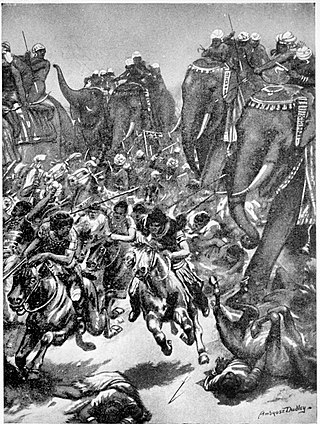
Yashodharman was a ruler of Malwa, in Central India, during the early part of the 6th century. He probably belonged to the Second Aulikara dynasty. He conquered much of the Indian subcontinent between c. 530-540 AD according to Mandsaur pillar inscription.

Shashanka was the first independent king of a unified polity in the Bengal region, called the Gauda Kingdom. He reigned in the 7th century, some historians place his rule between c. 600 and 636/7 CE, whereas other sources place his reign between 590 and 625 CE.

Avanti, was an ancient Indian Mahajanapada, roughly corresponding to the present-day Malwa region. According to the Buddhist texts, the Anguttara Nikaya, Avanti was one of the solasa mahajanapadas of the 6th century BCE. The janapada was divided into two parts by the Vindhyas, the northern part had its capital at Ujjayini and the southern part had its centre at Mahishmati.
The historical Avanti Kingdom of ancient India is described in the Mahabharata epic. Avanti was divided into north and south by river Vetravati. Initially, Mahissati was the capital of Southern Avanti, and Ujjaini was of northern Avanti, but at the times of Mahavira and Buddha, Ujjaini was the capital of integrated Avanti. The country of Avanti roughly corresponded to modern Malwa, Nimar and adjoining parts of the Madhya Pradesh.
The Malavas or Malwas were an ancient Indian tribe. The malavas are Malhi/malli people (Malloi) who were settled in the Punjab region at the time of Alexander's invasion in the 4th century BCE. Later, the Malavas migrated southwards to present-day Rajasthan, and ultimately to Madhya Pradesh and Gujarat. Their power gradually declined as a result of defeats against the Western Satraps, the Gupta emperor Samudragupta, and the Chalukya emperor Pulakeshin II.

The history of Madhya Pradesh can be divided into three periods - the ancient period, the medieval period and modern period.
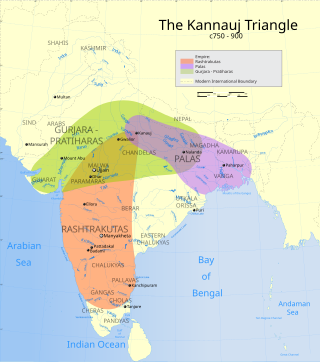
The Tripartite Struggle (785–816), also called the Kannauj Triangle Wars, was a conflict in northern India involving the three Indian great powers of the era – Gurjaratra, Bengal, and Manyakheta under the Pratiharas, the Palas and the Rashtrakutas respectively. The war was fought over the control of the Kingdom of Kannauj.
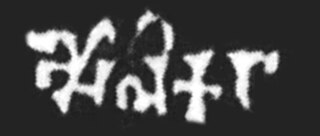
The Aulikara dynasty, was an ancient dynasty that ruled the Kingdom of Malwa between the 4th-century CE and 6th-century CE. They were based in the Malwa (Malava) region of central India near Mandsaur, with their power center near what is now western Madhya Pradesh, southeastern Rajasthan and northeastern Gujarat. Two royal houses belonging to this clan ruled over the present-day western Malwa region of Madhya Pradesh state from c. 350 CE to 550 CE, much of it as feudatories of the Gupta Empire.
The origin of the Gurjara-Pratihara dynasty of India is a topic of debate among historians. The rulers of this dynasty used the self-designation "Pratihara" for their clan, but have been described as "Gurjara" by their neighbouring kingdoms. Only one particular inscription of a feudatory ruler named Mathanadeva mentions him as a "Gurjara-Pratihara".

The Pushyabhuti dynasty, also known as the Vardhana dynasty, was the ruling dynasty of the Kingdom of Thanesar and later the Kingdom of Kannauj in northern India during the 6th and 7th centuries. The dynasty reached its zenith under its last ruler Harsha Vardhana, whose empire covered much of north and north-western India, extending till Kamarupa in the east and Narmada River in the south. The dynasty initially ruled from Sthanveshvara, but Harsha eventually made Kanyakubja his capital, from where he ruled until 647 CE.
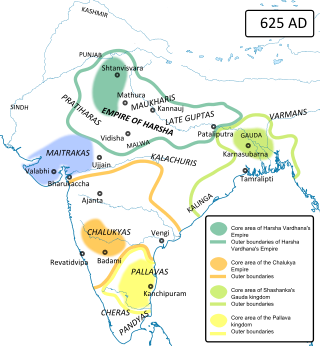
The Later Gupta dynasty ruled Magadha in eastern India between the 6th and 8th centuries CE. The Later Guptas succeeded the Imperial Guptas as the rulers of eastern Malwa or Magadha, but there is no evidence connecting the two dynasties; these appear to be two distinct families. The "Later Guptas" are so-called because the names of their rulers ended with the suffix "-gupta", which they might have adopted to portray themselves as the successors of the Imperial Guptas.
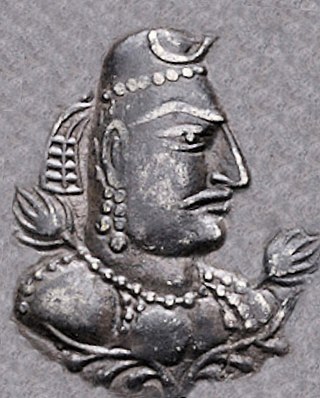
The Alchon Huns, also known as the Alkhan, Alchono, Alxon, Alkhon, Alakhana, and Walxon, were a nomadic people who established states in Central Asia and South Asia during the 4th and 6th centuries CE. They were first mentioned as being located in Paropamisus, and later expanded south-east, into the Punjab and Central India, as far as Eran and Kausambi. The Alchon invasion of the Indian subcontinent eradicated the Kidarite Huns who had preceded them by about a century, and contributed to the fall of the Gupta Empire, in a sense bringing an end to Classical India.
The Second Aulikara dynasty was a royal dynasty that ruled over the Malwa plateau, and at its peak under Yashodharman Vishnuvardhana controlled a vast area, consisting of almost all of Northern India and parts of Deccan plateau. It was the second royal house of the Aulikara clan.

The Battle of Sondani was a large military encounter fought in 528 CE, between the Alchon Hun emperor Mihirakula and a confederation of Indian rulers led by king Yashodharman of Malwa and Narasimhagupta of Gupta Empire
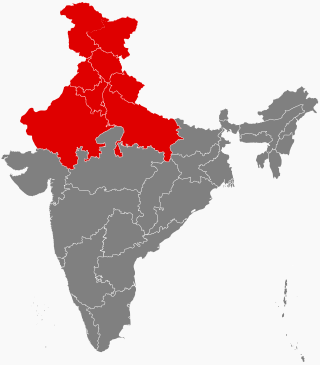
Northwest India is a loosely defined region of India consisting of north-western states of the Republic of India. It generally includes the states of Haryana, Himachal Pradesh, Punjab, Rajasthan Uttarakhand, and often Uttar Pradesh, along with the union territories of Chandigarh, Jammu and Kashmir, Ladakh, and the National Capital Territory of Delhi. Gujarat is occasionally included as well. The mountainous upper portion of Northwest India consists of the Western Himalayas, while the flat lower portion consists of the middle portion of the Indo-Gangetic plains and the Thar Desert.

The Kingdom of Kannauj was a kingdom in Northern India during the Early Mediaeval Era. It was established by Harivarman in 510 who was crowned Maharaja of Kannauj by the Magadhan Emperor. The kingdom of Kannauj expanded into a vast realm that spanned across northern India during the reign of Harshavardhana in the early seventh century.
Devagupta I was the last king of the rump state of Malwa in the western part of what had been the Magadhan Empire prior to the conquest of its eastern part by the Kingdom of Kannauj. He was the eldest son of Mahasenagupta and a member of the Later Gupta dynasty. Devagupta is known for having engineered a Malwa–Gauda alliance with Shashanka of Gauda to counter the Thanesar–Kannauj alliance. The alliance was initially successful, and Devagupta's forces reached Kannauj and killed the king of Kannauj. However, the king of Thanesar defeated Malwa and killed Devagupta, but was himself killed in the war with Gauda. Harsha succeeded him and defeated Gauda, finally winning the war.











